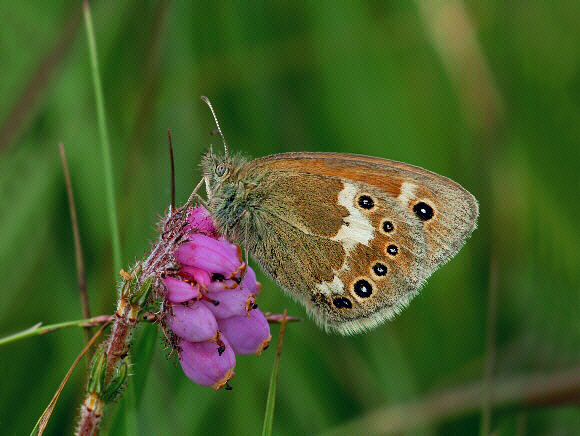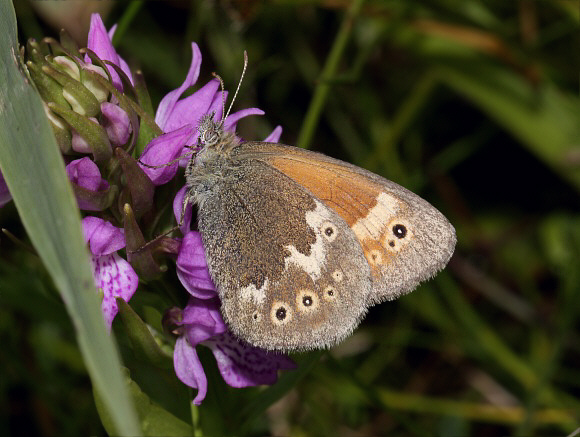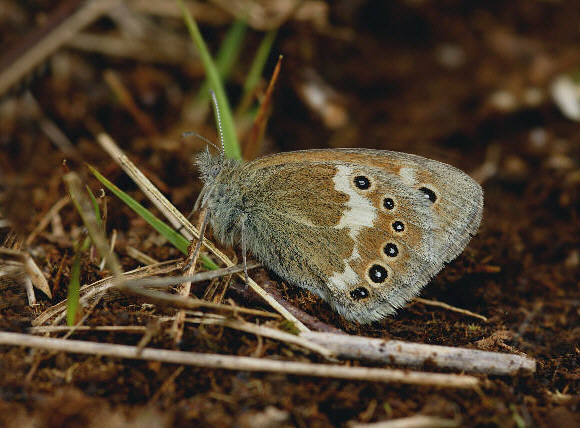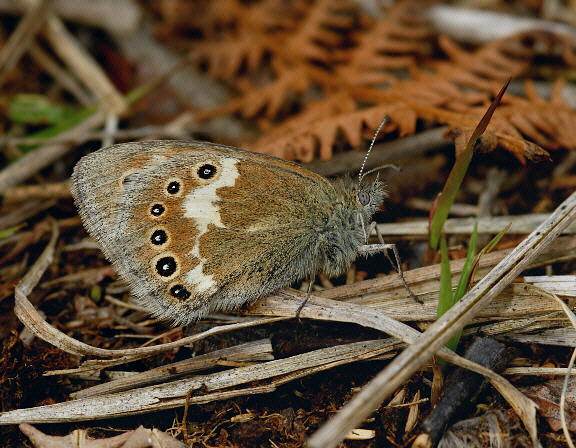 Coenonympha tullia tullia, form davus, Whixall Moss, Shropshire – Adrian Hoskins
Coenonympha tullia tullia, form davus, Whixall Moss, Shropshire – Adrian Hoskins
Introduction
The Large Heath is distributed across much of Europe, occurring in northern Britain, Scandinavia, north-east France, Germany, and eastwards across temperate Asia to Amurland. It also occurs across much of North America from Alaska to California in the west, to Newfoundland in the east.
There are several forms of the butterfly in Britain – polydama, found in north-east England, south-east Scotland, Wales and Northern Ireland; davus, found in Shropshire and north-west England; and scotica, from northern and western Scotland. The latter may possibly represent a valid sub-species, but the presence of transitional forms elsewhere in the butterfly’s British distribution range suggests that the species forms a cline, and that sub-species designations are invalid.
Most examples of davus from Shropshire and Cumbria tend to be brightly coloured and have very prominent ocelli on the underside wings, while scotica are virtually devoid of ocelli, and resemble over-sized Small Heaths. The most widespread form polydama is intermediate between the two.
It has been suggested by Mellor that the evolution or adaptation of these various forms or races is climate-related : Butterflies in the colder northern regions tend to be less active, even in sunny weather, and probably benefit from the camouflage afforded by their plainer undersides. Those at warmer sites further south however spend more time in flight and are likely to attract the attention of birds. Thus they may have developed ocelli on the outer wings to deflect bird attacks away from their bodies. Natural selection would therefore favour the retention or development of ocelli in southern populations.
 Coenonympha tullia Thorne Moors, Humberhead Peatlands NNR, Yorkshire – Adrian Hoskins
Coenonympha tullia Thorne Moors, Humberhead Peatlands NNR, Yorkshire – Adrian Hoskins
| Historically the Large Heath has been known by several alternative names including Scarce Heath, July Ringlet, Silver-bordered Ringlet, Marsh Ringlet, Manchester Argus and Gatekeeper. The latter name is now used for Pyronia tithonus which has also been known by several other English names including Hedge Brown, Hedge Eye, Small Meadow Brown and Large Heath. Thus the names Large Heath and Gatekeeper have at certain times in the past been interchangeable ! |
Habitats
In mainland Britain the Large Heath is found on boggy moors, peat mosses and raised blanket bogs. Most colonies are at low altitudes, and are characterised by the presence of scattered birch, pine, bilberry, bog myrtle, willow, and extensive flushes of the larval foodplant – hare’s tail cotton grass.
In the Scottish Highlands and Tayside the butterfly is often found on areas of flat boggy ground at altitudes as high as 760m. It is also found on Skye and most other Scottish islands, including the Outer Hebrides – desolate windswept lowlands, totally devoid of natural tree cover.
Large Heaths are highly sedentary in behaviour, rarely if ever moving beyond the bounds of the bog or moor where they emerge. They can form large colonies with populations of several thousand, but many sites have been drained and partially converted to farmland, leaving many colonies small and isolated, with rapidly diminishing populations.
 Coenonympha tullia tullia, form davus, Whixall Moss, Shropshire – Adrian Hoskins
Coenonympha tullia tullia, form davus, Whixall Moss, Shropshire – Adrian Hoskins
Lifecycle
In Britain there is a single generation of adults, emerging in late June or early July on lowland bogs in England, and about 3-4 weeks later on high altitude sites and in northern Scotland. In sub-arctic regions of Canada, Alaska and Eurasia it can take 2 years to complete the lifecycle.
The flight season is short, and the butterflies are short-lived – the average lifespan being only about 3 or 4 days as a result of heavy predation by meadow pipits and other birds.
The egg, which is straw coloured and spherical with a flattened top, is laid singly on the stems or blades of hare’s tail Eriophorum vaginatum, white-beaked sedge Rhynchospora alba, or more rarely on purple moor grass Molina caerulea. The eggs hatch after about 2 weeks.
The larvae hatch in late July, and feed diurnally until the cold nights of autumn induce them to enter hibernation. In the extreme north of their range they hibernate when very small, while further south they usually enter hibernation in the 2nd instar. In the spring after awakening from hibernation they often feed diurnally and can be found resting on the upper part of sedge stems. When full grown the larva is green with a dark green dorsal stripe, and a pair of white lines along each side. The head is green, and the anal prongs, used for ejecting faecal pellets, are pink.
The chrysalis is bright green, with blackish stripes in the wing cases, and hangs by the cremaster from the stems of grasses, sedges or shrubs. The pupal stage lasts for about 3 weeks.
 Coenonympha tullia tullia, form davus, Whixall Moss, Shropshire – Adrian Hoskins
Coenonympha tullia tullia, form davus, Whixall Moss, Shropshire – Adrian Hoskins
Adult behaviour
Large Heaths often rest for long periods, typically settling on mosses or amidst tussocks of grasses or sedges. They often bask amongst leaf litter or on patches of bare peat soil, with wings closed and tilted over to one side. They have a gentle bobbing flight, and are reluctant to settle while the sun shines, but dive into the grasses as soon as the sun is obscured by cloud.
When at rest in the grasses the butterflies are easily disturbed, even in weather conditions which would prevent other species from flying : to obtain the photographs on this page I had to drive for 4 hours to reach Whixall Moss, with the weather deteriorating rapidly as I headed northwards. By the time I arrived it was heavily overcast, and gale force winds were ripping off tree branches which littered the roads along the route. Having travelled so far I was determined to find a butterfly or two however, and set out across the moor, barely able to stand upright in the face of the wind. Even in these conditions the occasional Large Heath would fly up as I staggered along the tracks across the site. Most were instantly grabbed by the wind and blown a hundred metres across the wet boggy terrain, but two landed within sight, settling on the ground in sheltered hollows. I later found a third individual at rest on bell heather, where it was sheltered by a belt of oak woodland.
At Meathop Moss in Cumbria, and Moss of Achnacree in Strathclyde, I’ve watched the butterfly in more pleasant weather conditions ! The terrain at these and most other sites is very waterlogged. Chasing after butterflies is a risky business – much of the habitat appears to be safe to walk on but this is very misleading, as what seems to be dry ground can suddenly give way beneath your feet, and you can find yourself waist deep in a quicksand-like bog. The safest way to operate therefore is to stay on dry tracks, or very carefully walk on the higher ground, testing it with your feet as you go. Once stationed in a suitable spot butterflies will occasionally settle close enough for detailed study or photography. If disturbed they can fly very rapidly, covering distances of up to 200 metres before settling again, so it is pointless and dangerous trying to chase after them.
At Meathop I have seen the butterflies nectaring at cross-leaved heath, bramble and bell heather. They probably also nectar at marsh lousewort, and at orchids, both of which are profuse at many of their sites. At Meathop, Achnacree and Skye I have also observed males imbibing moisture from damp peaty soil.
I have not observed courtship behaviour in this species, and can find no reference to it in literature, but it is likely to be similar to that of the closely related Small Heath. I have however on several occasions found copulated pairs in the late morning. Copulation lasts for at least half an hour, often longer, and while copulated the pair take to the wing if disturbed, with the male carrying the female in flight.
Overnight or during spells of inclement weather the butterflies ordinarily roost deep amongst grass tussocks, but I have also found them clinging to twigs of birch saplings or bog myrtle bushes.
